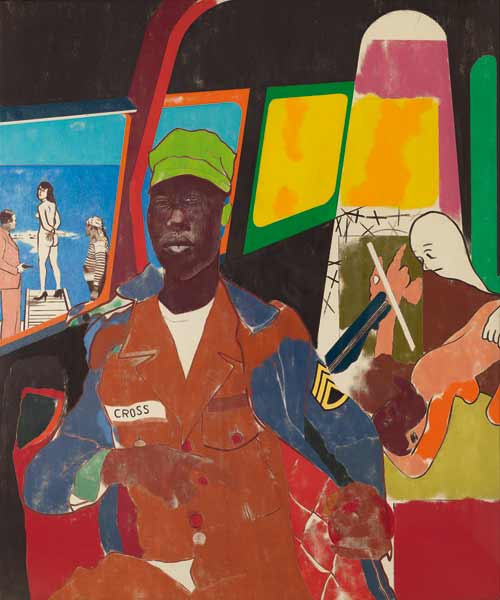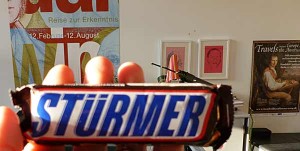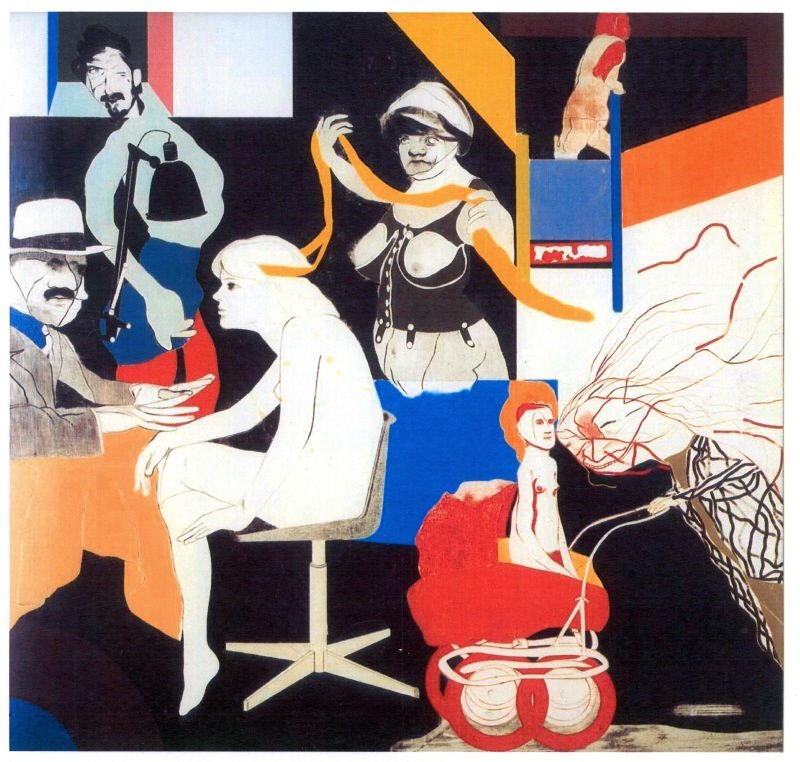
R.B. Kitaj, Juan de la Cruz, 1967 © R.B. Kitaj Estate. Astrup Fearnley Museum of Modern Art, Oslo
Only now do I realize, really examining my favorite Kitaj painting closely, that Juan de la Cruz also has those explicit and aggressive sexual components so peculiar to his work: naked women are a vehicle for political messages (here about the Vietnam War) and historical episodes, for instance about St. John of the Cross, St. Teresa of Avila, and their Jewish origins, which I find inherently problematic. Despite this, however, I like the painting: the many powerful colors, the deep blue sea under the brilliant blue sky, the green cap on the soldier’s head, and the yellow behind him. The painting and the contradictions it binds together – the soldier’s finely-drawn features beside the sober geometric forms – they emanate something of summer’s optimism.
For more on R.B. Kitaj, see: www.jmberlin.de/kitaj/en
Christine Marth, Publications
 I thought I was losing my visual cognition yesterday noon, at the Jewish Museum’s canteen, when a colleague bought a candy bar which looked like a snickers in every way except for the writing, which spelled STÜRMER. I turned out to be healthy. Consulting the website of chocolate makers Mars, Inc., I learned that STÜRMER-bars are part of a “happy day edition” campaign to boost sales during the European Football Championship. Sometimes, we get paranoid at the Jewish Museum, so I was quite relieved to find that not everybody associates STÜRMER (which means “striker”) with the notoriously anti-Semitic 1920s and 1930s publication…
I thought I was losing my visual cognition yesterday noon, at the Jewish Museum’s canteen, when a colleague bought a candy bar which looked like a snickers in every way except for the writing, which spelled STÜRMER. I turned out to be healthy. Consulting the website of chocolate makers Mars, Inc., I learned that STÜRMER-bars are part of a “happy day edition” campaign to boost sales during the European Football Championship. Sometimes, we get paranoid at the Jewish Museum, so I was quite relieved to find that not everybody associates STÜRMER (which means “striker”) with the notoriously anti-Semitic 1920s and 1930s publication…
Naomi Lubrich, Media
The preparations for the exhibition R.B. Kitaj (1932–2007) Obsessions at the Jewish Museum Berlin have brought me back to Philip Roth. I try to re-read him about every ten years.

R. B. Kitaj, The Ohio Gang, 1964 © R.B. Kitaj Estate 2012. Digital image, The Museum of Modern Art, New York/Scala, Florence
Why? Out of curiosity; to test my feminist – or better and more simply, my feminine – distaste for Roth; to see if my increasing maturity has stimulated some new cognitive process that allows me to encounter the aging, sex-obsessed, white, male ego of the Roth hero with more empathy; or at last to discover exactly why Roth is a reigning great of American literature, which he undisputedly is. It is said that the lecherous puppeteer Mickey Sabbath of “Sabbath’s Theater” is modeled on the author’s neighbor and friend, R.B. Kitaj, but others of Roth’s characters bear traits or biographical details in common with the artist. To sum up, I can’t yet confess that Philip Roth’s characters appeal to me, but I do notice that they have become in a way “historical,” a portrayal of their time. It isn’t dissimilar to the way one enjoys the groping chauvinists of Mad Men, without necessarily wishing to return to the age of oversexed secretaries and mousy housewives. In any case, the projected figure of the artist R.B. Kitaj has grown more vivid, more three-dimensional in my imagination – and I’m all the more excited to get acquainted with the “real” Kitaj beginning in September through the paintings at the Jewish Museum.
For more on R.B. Kitaj, see: www.jmberlin.de/kitaj/en
Signe Rossbach, Events curator


